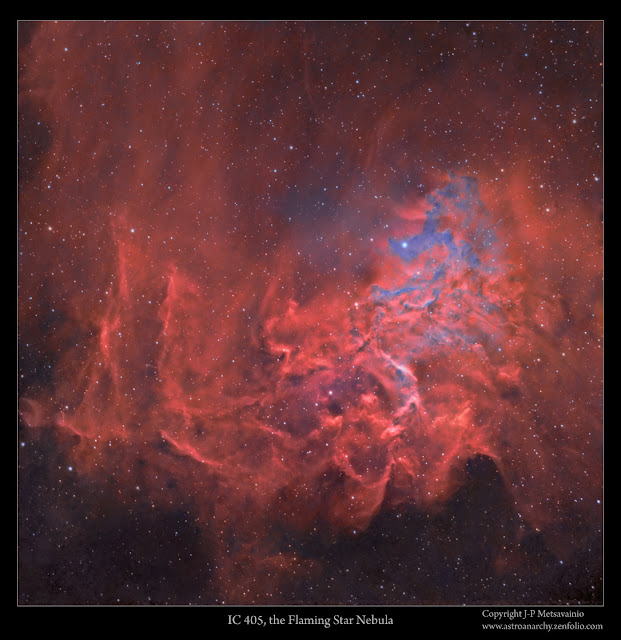COPYRIGHT, PLEASE NOTE
All the material on this website is copyrighted to J-P Metsavainio, if not otherwise stated. Any content on this website may not be reproduced without the author’s permission.
Have a visit in my portfolio
PORTFOLIO:https://astroanarchy.zenfolio.com/
Monday, February 16, 2015
IC 405, the Flaming Star Nebula
A new photo from the night of February 14. I tried something little different, than usually. I tried to capture the reflection nebula component in IC 405. Usually I don't shoot broadband data since in my location the light pollution dominating the sky. An hour with the blue filter showed the reflection component nicely, so I added it to the narrowband data. It can be seen as a bluish formation at middle right.
IC 405 (Sharpless 229, Sh2-229)
In constellation Auriga, click for a large image
Natural color composition from the emission of ionized elements, R=80%Hydrogen+20%Sulfur, G=100%Oxygen and B=85%Oxygen+15%Hydrogen to compensate otherwise missing H-beta emission. This composition is very close to a visual spectrum.
A closeup
From photo above, click for a large image
The reflection nebula can be seen as a blue color in this visual colors photo.
Emissions of ionized elements, hydrogen, sulfur and oxygen, are combined to a visual spectrum.
Broadband element is then added to a final image, since narrowband photo alone doesn't show it.
Image in mapped colors
Image is in mapped colors from an emission of the ionized elements. Golden areas
are from emission of sulfur and hydrogen, bluish hues are from ionized oxygen and some reflection nebula.
A closeup
The reflection component is visible in this narrowband photo of IC 405. It can be seen as a bluish color.
INFO
IC 405, the Flaming Star Nebula, is also known as Sharpless 229 (Sh2-229) or a Caldwell 31. It's a mixture of an emission and reflection components. Usually the reflection component is not visible in narrowband photos but I shot it separately with a blue filter. This nebula located in constellation Auriga at distance of about 1500 light years.
H-alpha emission in IC 405
An experimental starless version
The actual nebula stands out better without the stars.
Orientation in an older wide field photo
The are of interest is marked as a white rectangle. Info about this photo HERE
Technical details
Processing work flow
Image acquisition, MaxiDL v5.07.
Stacked and calibrated in CCDStack2.
Deconvolution with a CCDStack2 Positive Constraint, 33 iterations, added at 50% weight
Color combine in PS CS3
Levels and curves in PS CS3.
Imaging optics
Celestron Edge HD 1100 @ f7 with 0,7 focal reducer for Edge HD 1100 telescope
Cameras and filters
Imaging camera Apogee Alta U16 and Apogee seven slot filter wheel
Guider camera, Lodestar x2
Astrodon filter, 5nm H-alpha
Astrodon filter, 3nm O-III
Astrodon filter, 3nm S-II
Exposure times
H-alpha, 12 x 1200s = 4h
O-III, 3 x 1200s, binned 4x4 = 1h
S-II, 3x1200s, binned 4x4 = 1h
Red, 3 x 600s, binned 2x2=30min.
Green, 3 x 600s, binned 2x2=30min.
Blue, 6 x 600s, binned 2x2=1h
Total 8h
A single un cropped, calibrated and stretched 20 min. H-alpha frame
Labels:
Narrowband color images,
nebula
Subscribe to:
Post Comments (Atom)


















No comments:
Post a Comment